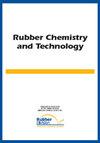A novel SBS compound via blending with PS-b-PMBL diblock copolymer for enhanced mechanical properties
IF 1.2
4区 工程技术
Q4 POLYMER SCIENCE
引用次数: 0
Abstract
Styrene-butadiene-styrene (SBS) rubbers stand as one of the most frequently employed thermoplastic elastomers globally. The upper operating temperature of SBS is limited by the glass transition temperature (Tg) of polystyrene, circa 100 °C. This study demonstrates a noteworthy enhancement in the properties of SBSs by introducing a diblock copolymer consisting of styrene and α-methylene-γ- butyrolactone (α-MBL). Polymers derived from α-MBL exhibit exceptional thermal stability, attributable to a glass transition temperature of 195 °C. Notably, α-MBL, also recognized as Tulipalin A, is a bio-renewable compound naturally found in tulips. This investigation encompasses both crosslinked and non-crosslinked blends of poly(styrene)-b-poly(α- methylene-γ-butyrolactone) diblock copolymer (PS-PMBL) and poly(styrene)-b-poly(butadiene)-b- poly(styrene) triblock copolymer, within the 0-20 wt.% PS-PMBL range. Thorough examination employing thermal analysis and linear shear rheology reveals that all blends surpass the properties of their pure SBS counterparts. Specifically, blending at 200 °C induces crosslinking between the polymers, yielding heightened Young’s modulus and complex viscosity, thereby resulting in a robust and rigid material compared to non-crosslinked blends. For non-crosslinked blends, an increase in strength is observed while maintaining commendable rubbery properties. Notably, the non-crosslinked blends permit the recycling of components (SBS and PS- PMBL) through the re-dissolving of rubber in tetrahydrofuran (THF). These findings present a promising avenue for the enhancement of rubbers through the incorporation of bio-renewable compounds.一种通过与 PS-b-PMBL 二嵌段共聚物共混提高机械性能的新型 SBS 化合物
苯乙烯-丁二烯-苯乙烯(SBS)橡胶是全球最常用的热塑性弹性体之一。SBS 的最高工作温度受限于聚苯乙烯的玻璃化转变温度(Tg),约为 100 ℃。本研究通过引入由苯乙烯和 α-亚甲基-γ-丁内酯(α-MBL)组成的二嵌段共聚物,显著提高了 SBS 的性能。由 α-MBL 制成的聚合物具有优异的热稳定性,其玻璃化转变温度为 195 ℃。值得注意的是,α-MBL 也被称为郁金香苷 A,是郁金香中天然存在的一种生物可再生化合物。这项研究包括聚(苯乙烯)-b-聚(α-亚甲基-γ-丁内酯)二嵌段共聚物(PS-PMBL)和聚(苯乙烯)-b-聚(丁二烯)-b-聚(苯乙烯)三嵌段共聚物的交联和非交联混合物,PS-PMBL 的重量百分比范围在 0-20% 之间。利用热分析和线性剪切流变学进行的彻底检查表明,所有混合物的性能都超过了纯 SBS 的同类产品。具体来说,在 200 ℃ 下进行混合会引起聚合物之间的交联,从而提高杨氏模量和复合粘度,因此与未交联的混合物相比,混合物具有坚固的刚性。对于非交联共混物,在保持值得称赞的橡胶特性的同时,还能提高强度。值得注意的是,通过在四氢呋喃(THF)中重新溶解橡胶,非交联共混物可以实现组分(SBS 和 PS-PMBL)的循环利用。这些发现为通过加入生物可再生化合物来增强橡胶性能提供了一条前景广阔的途径。
本文章由计算机程序翻译,如有差异,请以英文原文为准。
求助全文
约1分钟内获得全文
求助全文
来源期刊

Rubber Chemistry and Technology
工程技术-高分子科学
CiteScore
3.50
自引率
20.00%
发文量
21
审稿时长
3.6 months
期刊介绍:
The scope of RC&T covers:
-Chemistry and Properties-
Mechanics-
Materials Science-
Nanocomposites-
Biotechnology-
Rubber Recycling-
Green Technology-
Characterization and Simulation.
Published continuously since 1928, the journal provides the deepest archive of published research in the field. Rubber Chemistry & Technology is read by scientists and engineers in academia, industry and government.
 求助内容:
求助内容: 应助结果提醒方式:
应助结果提醒方式:


